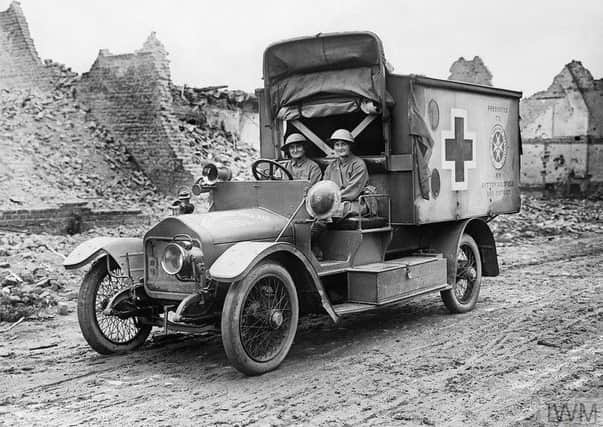Siobhán O'Connor and Alison O'Donnell: Elsie and Mairi Go To War '“ a tale of nursing bravery on the front line


The deadly conflict lasted four years and led to the death of an estimated 20 million soldiers and civilians across the continent and beyond. It divided Europe into two sides, the Allies of Great Britain, France, Belgium, Russia and later the USA, and the Central Powers which included Germany, Austria, Hungary and Turkey.
Britain entered the war on 4 August 1914 after Germany invaded Belgium. The western front of the First World War, running from the Belgian coast all the way to Switzerland, saw some of the deadliest warfare with trenches on both sides and a no man’s land in between.
Advertisement
Hide AdAdvertisement
Hide AdThat same year a young Scottish woman, Mairi Chisholm, left her home to join a friend and trained nurse Elsie Knocker as a volunteer dispatch rider for the Women’s Emergency Corps in London.
This organisation contributed to the war effort by training women doctors, nurses and motorcycle messengers. As Mairi and Elsie were keen motorcyclists, an unusual hobby for women at the time, they put their skills to good use. While working in London, both women were asked by Dr Henry Munro, a British medical doctor, to join his Flying Ambulance Corps in Belgium near the front lines of the war.
Mairi and Elsie worked tirelessly picking up wounded soldiers and transporting them to a field hospital in Furnes to nurse them back to health. This was not always possible as an excerpt from Mairi’s diary at the time reads: “No one can understand...unless one has seen the rows of dead men laid out. One sees men with their jaws blown off, arms and legs mutilated.”
Both women felt they could save more lives by working closer to the front lines, as many soliders died while they transported them to hospital. Towards the end of 1914, Elsie and Mairi set up their own first aid post at a town called Pervyse in Belgium, only 100 yards from the trenches. They spent the next three and a half years treating wounded British, Belgian and even German soldiers, some of whom they rescued from the battlefield.
During the war Mairi and Elsie received numerous medals and awards for bravery including the Chevaliers de l’Ordre de Léopold from King Albert of Belgium and the British Military Medal.
Mairi was also decorated with the Queen Elizabeth Medal of Belgium and the 1914 Star, the British First World War campaign medal for service. They became instant celebrities, were widely photographed and known as the Madonnas of Pervyse, returning periodically to Britain to fundraise money to continue their nursing work on the front lines.
In March 1918, both Mairi and Elsie became very ill after a German bombing raid and gas attack struck their first aid post in Pervyse. Their driver and pet dog were killed but the two women, their orderly, a doctor and patients managed to survive.
After recovering in a hospital in London, Mairi returned to the front lines a few weeks later but Elsie was too ill to do so. Due to constant bombardment of the West Flanders region of Belgium by the Germany army, Mairi was forced to abandon her first aid post a few months before the end of the war.
Advertisement
Hide AdAdvertisement
Hide AdOn returning to Britain she joined Elsie as an officer in the newly formed Women’s Royal Air Force, to help train women as clerks, mechanics and other tradespeople contributing to the Royal Air Force.
When the war ended Mairi returned to Nairn and became a poultry breeder on a friend’s estate due to her poor health. She then moved to Jersey for a period and eventually came back to Scotland and lived near Oban for the rest of her life until she died in 1981, aged 85.
Elsie lost contact with Mairi after the war but continued to live in England, working in a variety of roles. She died in 1978, aged 93. A bronze statue of these two great nursing heroines now stands at Ypres, Belgium to honour their courage and commitment.
The Royal Society of Edinburgh (RSE) and the RSE Young Academy of Scotland, in collaboration with the Royal College of Nursing Scotland, are hosting a free public exhibit exploring nursing during the First World War from 5 to 12 November at the RSE offices on 22-26 George St, Edinburgh to commemorate the 100-year anniversary of the end of the First World War.
Mairi Chisholm and other well-known nurses from this period will be featured, as well as Fellows of the RSE who served in the war.
A storytelling session with Dr Diane Atkinson, who authored the book Elsie and Mairi Go to War, will be held at the RSE on Friday 9 November (6:00pm–7:15pm). More information on the event and exhibition is available on the RSE website at www.rse.org.uk/event/nursing-stories-from-the-first-world-war-a-conversation-with-dr-diane-atkinson/
Siobhán O’Connor, School of Health and Social Care, Edinburgh Napier University and member of the Young Academy of Scotland, and Alison O’Donnell, History of Nursing Society, Royal College of Nursing Scotland.